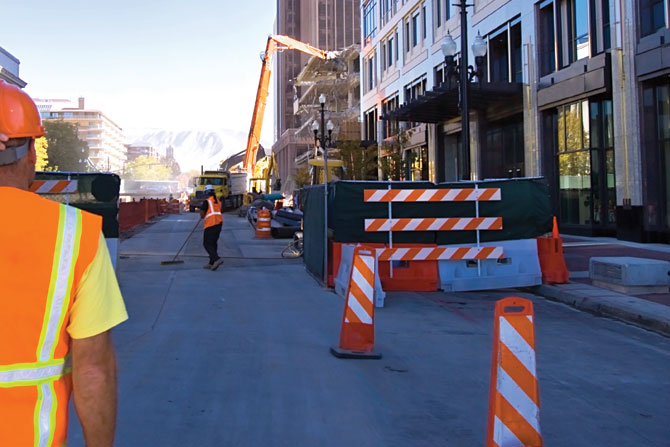The Salt Lake Chamber Board of Directors and the University of Utah’s Kem C. Gardner Policy Institute released a presentation in May 2021 about Utah’s need to build. As they pointed out, the difference between drifting and mastery occurs when people take challenges and turn them into opportunities.
The report’s authors saw a need for capital growth in three areas:
- Physical: Infrastructure is an important way to prepare for future needs.
- Structural: This consists of investing in people.
- Social: Investing in the community is a way to compensate for a decline in what institutions can provide to those who need help.
Let’s examine the need for physical infrastructure first. Between 2010 and 2020, Utah grew 18.4%. The population increased over those 10 years by 507,731 people, but 330,489 of those people were classified as “natural increase”: that is, babies. Net migration accounted for the remaining 177,242. How does that increase look in terms of percentages? Natural increase accounted for 65% of Utah’s growth, and net migration accounted for 35%.
If you compare Utah against other states, it is classified as a mid-sized state. California, Texas, and Florida take the top three spots. New York is ranked fourth. Utah is at No. 30, and Wyoming is at No. 50. The other surrounding states are Colorado (21), New Mexico (36), Arizona (14), Nevada (32), and Idaho (38).
The Bureau of Economic Analysis (BEA) and Moody’s Analytics keep records about infrastructure spending as a percentage of Gross Domestic Product (GDP). Infrastructure investments grew after World War II, peaked between 1960 and 1965 and have generally declined ever since. As of 2020, it was less than 2% of GDP. That is a small percentage, but it is a small percentage of a large number. The GDP in 2020 was $20,936.60 billion. The lowest level, which occurred before 1968, was $543.30 billion.
When looking at structural economic changes, it’s important to separate structural changes from cyclical ones. You can wait out a cyclical change, but if it is a structural one, the wisest course of action is to recognize that as soon as possible and make changes accordingly.
There are four broad categories of structural economic changes currently going on:
- Behavioral: The pandemic forced companies to send many employees home to work. Some people liked that, and they haven’t wanted to go back into the office. Other people decided the pandemic was a good point to either retire or change careers. Businesses the world over shortened their supply chains and began getting materials closer to home. Many also reshored their business operations.
- Technology: People needed broadband and tech-enabled services, and companies have been providing them. Most organizations would probably have moved far more slowly toward holding, say, online Zoom meetings if they hadn’t had to contend with the pandemic. In addition to business meetings, you could suddenly watch people performing Shakespeare. Celebrities gave concerts. For months, churches held online services as a primary means of worship.
- Demographics: This change has to do with migration and an aging population. When it was no longer necessary to live close to where you work, Zoom Towns sprung up, and people began to think about location in terms of their quality of life instead of a commute to the office. Also, as mentioned above, the pandemic gave many people the excuse they needed to retire or redirect their careers. The youngest baby boomers are now in their 57th year. According to the Pew Research Center, 28.6 million boomers retired during Q3 2020. That was an increase of 3.2 million from Q3 2019. Before that, an average of approximately 2 million boomers per year had been retiring.
- New paradigms: The pandemic caused people to reevaluate their needs in terms of banking, business travel, commercial real estate, mental health and the pandemic’s impact on women and other disadvantaged people, especially racial minorities and those without financial reserves.
Utah is well-positioned to move forward if its leaders and business community continue to make good decisions for all aspects of the state’s infrastructure.
Education continues to be a priority, but not necessarily white-collar education. As tuition and student debt have increased, it’s reasonable to ask what the benefit of higher education is relative to the price tag. A degree in engineering or computer science is valuable. But although a humanities degree is rewarding in other ways, it probably won’t be as financially rewarding unless coupled with other skills.
Skilled trades continue to be valuable. Young people (especially women) need a better understanding of why a practical education can be valuable. More, it isn’t a negative reflection on anyone’s intelligence if someone chooses to go into a trade. More and more computers of one sort or another can be found in cars, paving equipment, and other technically advanced devices, which means computer literacy is a marketable skill.
Next, consider social institutions. It can be useful to think of social institutions in terms of shared living experiences. There are many different places where people interact and can be seen:
- Churches
- Clubs
- Companies
- Courts
- Families
- Governments
- Health care
- Legislatures
- Media platforms
- Military organizations
- Schools
- Universities
How much do people trust these institutions?
The Edelman Trust Barometer measures trust on a global scale. According to the 2021 report, the impact of the COVID-19 pandemic has been equal to the Great Depression. The world’s two largest economies are the U.S. and China. In both countries, the surveyed respondents trust their governments less than they used to. The exception to this is the business community. At 61%, people trust businesses more than NGOs (57%), governments (53%) or media (51%).
What about Utah? It turns out that Utah leads the nation in its social capital; that is, the strength of its relationship networks. According to the U.S. Congress Joint Economic Committee, which measured 32 different aspects of social capital, Utah ranked 2.08. (Minnesota and Wisconsin also ranked high, at 1.81 and 1.61, respectively.)
Utah is well-positioned to move forward if its leaders and business community continue to make good decisions for all aspects of the state’s infrastructure. That includes building roads and bridges, of course, but it also includes recruiting people for the asphalt industry and ensuring everyone has the support they need.






